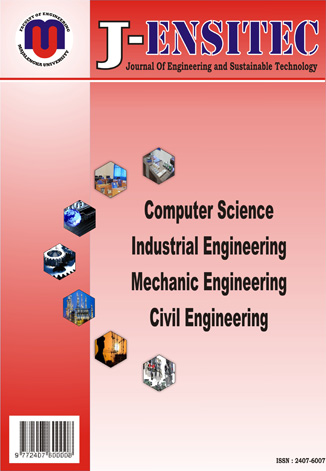ANALISIS KESELAMATAN DAN KESEHATAN KERJA DENGAN MENGGUNAKAN METODE HIRARC: SEBUAH STUDI KASUS
DOI:
https://doi.org/10.31949/jensitec.v10i01.6683Abstrak
This case study is situated in a manufacturing company operating in the production of PVC pipes in East Java, where human involvement plays a significant role in the production process. Through observations, numerous production and operational processes were found to pose risks to the safety and health of the workers. The abundance of potential hazards and risks to the safety and health of the workers needs to be reduced by implementing the HIRARC method. This method consists of a series of activities that begin with hazard identification, risk assessment, and the determination of control measures based on collected data. The analysis using the HIRARC method revealed the identification of 24 hazards, with 9 of them categorized as medium risk, and there were 11 types of activities/hazard risks classified as high risk, along with 4 extreme risk situations.
Kata Kunci:
Hazard, Health, Safety, Environment, Human LabourUnduhan
Referensi
Bahari, C., & Brahim, B. (2016). PENGARUH KESELAMATAN DAN KESEHATAN KERJA (K3) TERHADAP KINERJA KARYAWAN PT. BEHAESTEX GRESIK (2). 2(2), Article 2. https://doi.org/10.55129/.v2i2.240
Castillo, A., Bilbao, A., & Bilbao, E. (2007). A Risk Management Method Based on the AS/NZS 4360 Standard. 2007 41st Annual IEEE International Carnahan Conference on Security Technology, 64–68. https://doi.org/10.1109/CCST.2007.4373469
Gusmita, E. (2018). PENGARUH KESELAMATAN DAN KESEHATAN KERJA (K3) TERHADAP PRODUKTIVITAS KERJA PEGAWAI PADA BADAN PENANGGULANGAN BENCANA DAERAH KOTA SUNGAI PENUH: EMILYA GUSMITA, S.Sos., M.Pd. JURNAL ADMINISTRASI NUSANTARA, 1(2), Article 2. https://doi.org/10.51279/jan.v1i2.45
Irwansyah, M., Lady, L., & Umiyati, A. (2017). Pengendalian Risiko Kecelakaan Kerja pada Proses Bongkar Muat Produk dengan Pendekatan HIRA (Studi Kasus di PT. XYZ). Jurnal Teknik Industri Untirta, 0(0), Article 0. https://jurnal.untirta.ac.id/index.php/jti/article/view/1431
Jeffry Yuliyanto Waisapi. (2022). Keselamatan dan Kesehatan Kerja dan Lingkungan. Formosa Journal of Social Sciences (FJSS), 1(3), 285–298. https://doi.org/10.55927/fjss.v1i3.1286
Kurnianingtias, M. (2022). Analisis Manajemen Risiko Keselamatan dan Kesehatan Kerja (K3) dengan Metode Hazard Identification Risk Assessment and Risk Control (HIRARC) di Workshop Garmen Kampus Tekstil. Jurnal Tekstil: Jurnal Keilmuan Dan Aplikasi Bidang Tekstil Dan Manajemen Industri, 5(2), 77–87. https://doi.org/10.59432/jute.v5i2.37
Nalhadi, A., & Rizaal, A. (2015). IDENTIFIKASI BAHAYA DAN PENILAIAN RISIKO K3 PADA TINDAKAN PERAWATAN & PERBAIKAN MENGGUNAKAN METODE HIRARC (HAZARD IDENTIFICATION AND RISK ASSESMENT RISK CONTROL) PADA PT. X.
Pamungkas, M., Nuridin, & Rahayu, K. (2022). Hukum Keselamatan dan Kesehatan Kerja bagi Pekerja Proyek Konstruksi: Perbandingan Indonesia dan Malaysia. Penerbit NEM.
Pangkey, F., Malingkas, G. Y., & Walangitan, D. O. R. (2012). PENERAPAN SISTEM MANAJEMEN KESELAMATAN DAN KESEHATAN KERJA (SMK3) PADA PROYEK KONSTRUKSI DI INDONESIA. 2(2).
Purba, H. I. D., Girsang, V. I., & Siadari, S. M. (2019). Dampak Sosialisasi Kebijakan Keselamatan Dan Kesehatan Kerja Terhadap Pelaksanaan Keselamatan Dan Kesehatan Kerja. JURNAL MUTIARA KESEHATAN MASYARAKAT, 4(1), Article 1.
Purnama, G. N. T. (2018). PENGEMBANGAN SDM UNTUK MENINGKATKAN KINERJA TERKAIT KESELAMATAN KERJA (STUDI KASUS DI PT. XYZ). Jurnal Inkofar, 1(1). https://doi.org/10.46846/jurnalinkofar.v1i1.51
Ramadhan, F. (2017). Analisis Kesehatan dan Keselamatan Kerja (K3) Menggunakan Metode Hazard Identification Risk Assessment and Risk Control (HIRARC).
Raysha Adha Saputra & Ferida Yuamita. (2023). ANALISIS PROGRAM KESELAMATAN DAN KESEHATAN KERJA DENGAN PENDEKATAN FAULT TREE ANALYSIS PADA CV BESTONE INDONESIA. Jurnal Cakrawala Ilmiah, 2(12), 4607–4614. https://doi.org/10.53625/jcijurnalcakrawalailmiah.v2i12.6392
Sukwika, T. (2023). Manajemen Risiko: Pengendalian Risiko Lingkungan (pp. 92–123).
Susanti, E., Sugianto, W., Sabillah, A. I., & Wibowo, S. A. (2019). Analisa Pengaruh Manajemen Resiko dan Perilaku Kerja Aman Terhadap Kinerja Pekerja Shipyard Kota Batam. Prosiding Seminar Nasional Ilmu Sosial dan Teknologi (SNISTEK), 2, Article 2.
Sutowijoyo, H., Isramaulana, A., & Mudjanarko, S. W. (2020). Tinjauan Analisis Risiko Keselamatan Proyek Konstruksi Pabrik Pengolahan Kelapa Sawit di Kalimantan Selatan. AGREGAT, 5(2). https://doi.org/10.30651/ag.v5i2.6585
Yulianto, F. rakhman. (2022). IDENTIFIKASI BAHAYA KECELAKAAN KERJA DI PT.TOSHIN PRIMA FINE BLANKING MENGGUNAKAN METODE JOB SAFETY ANALYSIS DAN HAZARD IDENTIFICATION, RISK ASSESMENT AND RISK CONTROL. JUSTI (Jurnal Sistem Dan Teknik Industri), 2(2), Article 2. https://doi.org/10.30587/justicb.v2i2.3569
Yusuf, M. F. R., & Effendy, D. (2022). Pelaksanaan Keselamatan Kerja di PT. Kanza Sejahtera berdasarkan Peraturan Menteri Pekerjaan Umum dan Perumahan Rakyat Nomor 21/PRT/M/2019 Dihubungkan dengan Undang-Undang Nomor 1 Tahun 1970. Bandung Conference Series: Law Studies, 2(1), Article 1.
Diterbitkan
Cara Mengutip
Terbitan
Bagian
Lisensi
Hak Cipta (c) 2023 Prayonne Adi

Artikel ini berlisensiCreative Commons Attribution-ShareAlike 4.0 International License.
An author who publishes in the J-ENSITEC (Journal of Engineering and Sustainable Technology) agrees to the following terms:
- Author retains the copyright and grants the journal the right of first publication of the work simultaneously licensed under the Creative Commons Attribution-ShareAlike 4.0 License that allows others to share the work with an acknowledgment of the work's authorship and initial publication in this journal
- The author is able to enter into separate, additional contractual arrangements for the non-exclusive distribution of the journal's published version of the work (e.g., post it to an institutional repository or publish it in a book) with the acknowledgment of its initial publication in this journal.
- The author is permitted and encouraged to post his/her work online (e.g., in institutional repositories or on their website) prior to and during the submission process, as it can lead to productive exchanges, as well as earlier and greater citation of the published work







